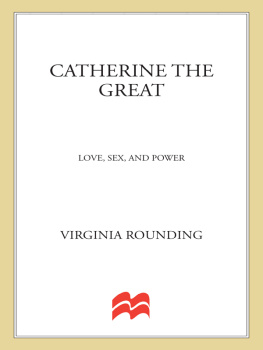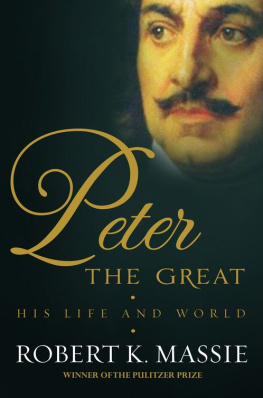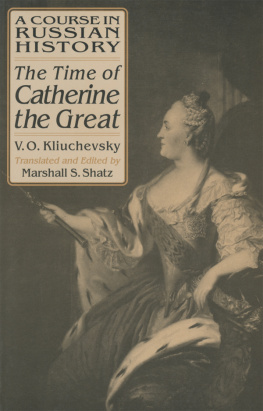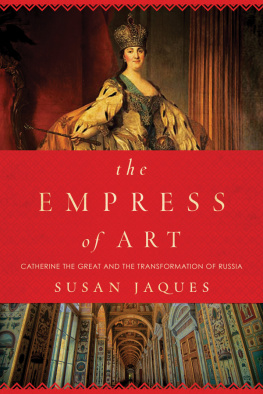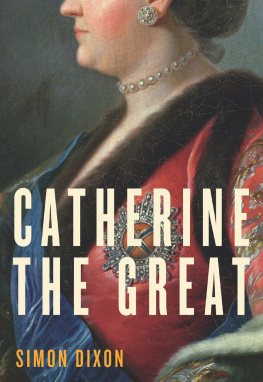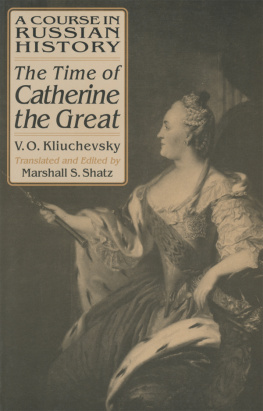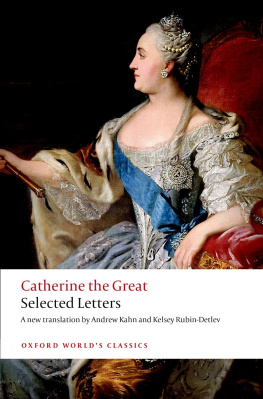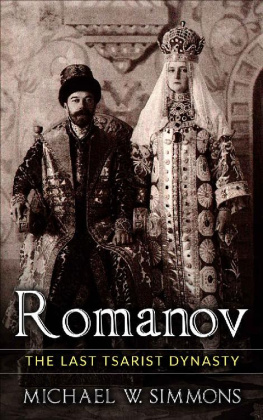List of Illustrations
Section One
Portrait of Christian August of Anhalt-Zerbst by Antoine Pesne(?), oil on canvas, 1725, The State Hermitage Museum, St Petersburg, Russia.
Portrait of Johanna Elizabeth, Princess of Anhalt-Zerbst by Antoine Pesne(?), oil on canvas, c . 1746, The State Hermitage Museum, St Petersburg, Russia.
Portrait of Empress Elizabeth Petrovna by Louis Tocque, oil on canvas, 1758, The State Hermitage Museum, St Petersburg, Russia.
Portrait of Catherine the Great (172996) and Prince Petr Fedorovich (172862) 174045, oil on canvas, by Georg Christoph Grooth (171649) Odessa Fine Arts Museum, Ukraine/Bridgeman Art Library.
Portrait of Petr Fedorovich (172862) 1758, oil on canvas, by Fedor Stepanovich Rokotov (c. 17351808) State Russian Museum, St Petersburg, Russia/Bridgeman Art Library.
Portrait of Grand Prince Paul Petrovich in the Classroom by Virgilius Erichsen, oil on canvas, 1766, The State Hermitage Museum, St Petersburg, Russia.
Portrait of Catherine II in Profile by Virgilius Erichsen, oil on canvas, before 1762, The State Hermitage Museum, St Petersburg, Russia.
Portrait of Catherine II by Alexei Petrovich Antropov, oil on canvas, before 1766, The State Hermitage Museum, St Petersburg, Russia.
Portrait of Count Grigory Grigoryevich Orlov by Andrei Ivanovich Cherny(?), enamel on copper, late 1760s to early 1770s, The State Hermitage Museum, St Petersburg, Russia.
Portrait of Alexei Bobrinsky in a Masquerade Costume (artist unknown), oil on canvas, late 1770s, The State Hermitage Museum, St Petersburg, Russia.
Portrait of Catherine II in front of a Mirror by Virgilius Erichsen, oil on canvas, between 1762 and 1764, The State Hermitage Museum, St Petersburg, Russia.
Section Two
Portrait of Stanislas II Augustus (173298), 1797, oil on canvas, by Marie Louise Elizabeth Vige-Lebrun (17551842) Chteau de Versailles, France/Bridgeman Art Library.
Portrait of Prince Grigory Alexandrovich Potemkin by Johann Baptist Edler von Lampi, oil on canvas, c. 1790, The State Hermitage Museum, St Petersburg, Russia/Bridgeman Art Library.
Baron Melchior Grimm (17231807), pencil on paper, by Carmontelle, (Louis Carrogis) (17171806), Muse Conde, Chantilly, France Giraudon/Bridgeman Art Library.
Giovanni Paesiello (17401816), oil on canvas, by Marie Louise Elizabeth Vige-Lebrun (17551842) Chteau de Versailles, France Lauros/Giraudon/Bridgeman Art Library.
Catherine IIs Uniform Dress Modelled after the Uniform of the Life-Guards Preobrazhensky Regiment, silk, metal thread, metal and galloon, gilded, 1763, The State Hermitage Museum, St Petersburg, Russia.
Catherine IIs Uniform Dress Modelled after the Uniform of the Life-Guards Cavalry Regiment, silk, metal thread, metal and galloon, gilded, 1773, The State Hermitage Museum, St Petersburg, Russia.
Portrait of Grand Duke Paul Petrovich by Alexander Roslin, oil on canvas, 1777, The State Hermitage Museum, St Petersburg, Russia.
Portrait of Grand Duchess Maria Fyodorovna by Alexander Roslin, oil on canvas, 1777, The State Hermitage Museum, St Petersburg, Russia.
Portrait of Grand Dukes Alexander Pavlovich and Constantine Pavlovich by Richard Brompton, oil on canvas, 1781, The State Hermitage Museum, St Petersburg, Russia.
Portrait of Count Semyon Zorich (unknown artist), oil on canvas, The State Hermitage Museum, St Petersburg, Russia.
Portrait of Alexander Lanskoy (unknown artist), oil on canvas, 1783/84, The State Hermitage Museum, St Petersburg, Russia.
Portrait of Alexander Dmitriyev-Mamonov by Mikhail Shibanov (copy), oil on canvas, 1800, The State Hermitage Museum, St Petersburg, Russia.
Portrait of Catherine II Wearing a Kokoshnik (Womans Headdress) by Virgilius Erichsen (copy), oil on canvas, (original painting 176972), The State Hermitage Museum, St Petersburg, Russia.
Portrait of Catherine II (172996) by Vladimir Lukich Borovikovsky (17571825) Tretyakov Gallery, Moscow, Russia/Bridgeman Art Library.
Portrait of Catherine II the Great (172996) in a Travelling Costume, 1787 (oil on canvas) by Mikhail Shibanov (fl. 178389) State Russian Museum, St Petersburg, Russia/Bridgeman Art Library.
Portrait of Catherine II (172996) (oil on canvas) by Albertrandi, Anton (c. 17301808) Royal Castle, Warsaw, Poland Maciej Bronarski/Bridgeman Art Library.
Portrait of Catherine II (172996) of Russia (oil on canvas) by Alexander Roslin (171893) Muse des Beaux-Arts, La Rochelle, France/Bridgeman Art Library.
What is certain is that I have never undertaken anything without having been intimately persuaded that what I was doing conformed to the good of my Empire. This Empire had done everything for me: - I believed that all my individual faculties, constantly employed for the good of this Empire, for its prosperity, for its superior interest, could hardly suffice to acquit myself towards it.
Foreword
Faced with the enormous task of writing about Catherine the Great enormous both because of the length of her reign and the amount of material to be covered, and because of the eminent qualities of some of those who have written about her before I was encouraged by two remarks of Nancy Mitford in letters to her friend, the bookshop proprietor Heywood Hill. First, discussing the project she had undertaken to write about Madame de Pompadour: Miss M. Trouncer [Margaret Trouncer, a Francophile biographer] has been to the library here APPALLED that Im doing it, furiously angry, says I must be mad, theres nothing more to say on the subject. And secondly, talking of her biography of Louis XIV: Actually, if there is interest in the subject at all, my book is utterly different from [Vincent] Cronins, we hardly touch on the same things. Such an immense reign, well documented, makes that almost inevitable each person does what interests him. Having always admired Miss Mitfords ability to entertain her readers and to wear her learning lightly, and agreeing with her that every writer undertaking such a subject will produce something quite different from any other, I make no apology for writing about what interests me in the life of Catherine II, also called the Great, of Russia.
This does not pretend to be a definitive once-and-for-all biography, containing everything that is known about Catherine. She is someone about whom books will probably go on being written for as long as people go on writing and reading books. I deliberately do not go into lengthy detail about Russian foreign and diplomatic policy in the eighteenth century and would refer readers to books such as Isabel de Madariagas Russia in the Age of Catherine the Great if that is what they are interested in. What I attempt to do is present Catherine the woman, the multi-faceted, very eighteenth-century woman, principally through her own words and those of her contemporaries, drawing out from the volumes of material written by them and by the Empress herself those particular observations, comments and conversations which allow her to appear most vividly before our eyes. I have chosen to tell a chronological narrative, rather than use a thematic approach, for it is in watching Catherines life unfold day by day that one sees the sheer scope of that life, the extent of the tasks she set herself and the range of activities she managed to encompass.
In allowing Catherine to come into as clear a focus as possible at a distance of over 200 years, I do not want to tell my readers what to think of her. But I do want to put paid to the more salacious rumours which have sullied her reputation so unjustly, even in her own lifetime but particularly since her death. That this most civilised of women should be known by most people only in relation to the infamous and entirely untrue horse story is one of the greatest injustices of history.

